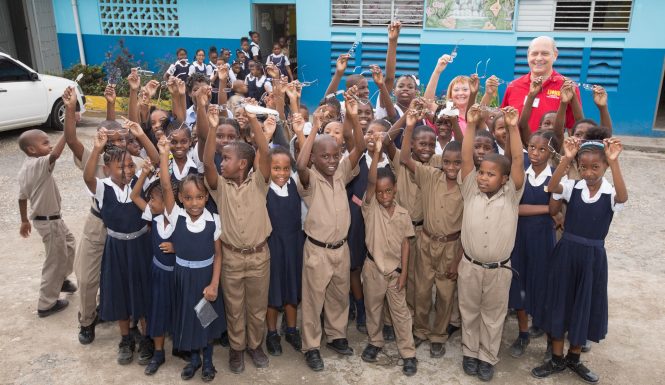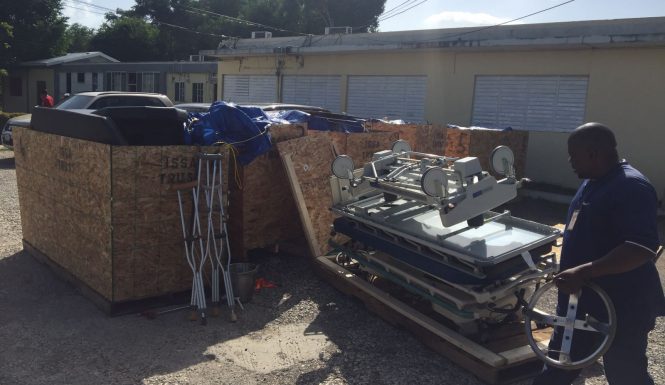Blog
18
November
4 weeks in Jamaica has flown by! This rotation has been one of the highlights of the year, and we are a day away from heading back to 5 degree weather and rain. I will miss the people of Jamaica – their friendly smiles, greetings, and the adorable babies with full heads of hair! The variety of clinical settings we have worked in has been a great. We worked in 3 different community sites – Port Maria Hospital on Mondays and Tuesdays, Annotto Bay Hospital on Wednesday and Thursdays, and Port Antonio on Fridays. We worked on the inpatient wards, the A&E (accident and emergency) department, the hospital clinic, and a health clinic. This elective has been a great opportunity to solidify 4 years of pediatric training, and work autonomously within a medical system with limited resources. Though we may have had the most dedicated pediatric training in the A&Es and health clinic, medical knowledge is only one part of patient care, and learning to navigate the medical system, choosing the most appropriate (and available) investigations and treatment, and accessing interdisciplinary resources was a challenge that pushed me to better refine my critical thinking and clinical skills.
The medicine here is great for a general pediatrician. There was some common pathology here that I rarely saw at home (scabies, tinea capitus and kerion, furuncles, tinea corporis, extranumerary digit, large abdominal hernias, infected styes). There was pathology I was very familiar with (asthma, eczema, viral illness, AOM, gastroenteritis, concussion, bronchiolitis, Coxsackie virus, febrile seizures etc), and there were some interesting cases (gasoline burn, vitamin ingestion, motor vehicle accident). Having come during “winter time” in Jamaica, there were many viruses going around. While many patients presented with viral symptoms, some had convincing history and physical exams suggestive of bacterial infections. Choosing the most appropriate antibiotic based on what was available at the pharmacy, or what the parents could afford at the private pharmacy had challenges, and often times, second line or third line antibiotics would be prescribed due to these limitations. Getting cultures done were often futile as samples (if not lost) and results are shipped out to and back from Kingston, and could take weeks. Without an EMR system, bloodwork is labelled by hand, paper blood results are physically transported, X-rays are printed on films, and all patient information is recorded by hand. I learned to actively ask myself why I was ordering specific investigations and how results would change my management, something I will take home with me, especially in my future career as a pediatric emergency physician.
The most enjoyable part of the elective has been interacting with the Jamaican people – they are friendly, kind, and genuine. They appreciate the work that we do, and ask us when we will be back. Parents who came from areas more than an hour away came to clinics before 7am in the morning to register, and waited patiently until physicians were able to see their child. Parents were only grateful and appreciative to have a physician see them, despite sometimes waiting for more than 8 hours. One of the biggest impacts we can have on the patients we see is education – teaching parents about their child’s condition, explaining what we think their child may have, and what the medications we prescribe do and how to take them.
I am also fortunate to have had a colleague and great friend come work beside me over the last 4 weeks. The benefits of having his clinical perspective and expertise in discussing cases where the diagnosis or treatment plan was not straight forward helped me feel more comfortable in my final management. I am grateful we were able to support each other in learning around our cumulative interesting cases, and navigating an unfamiliar medical system.
Lastly, I would like to acknowledge the great work that the Issa Foundation does to help improve the health and quality of life for young Jamaicans. During my time here, we saw grass roots progress being made: sustainable equipment delivered to hospitals with in-service teaching provided, and vision screening at schools with glasses given out to children who needed them. For me, working within a fantastic organization was important in participating in an elective to ensure that there was continuity with the work we do.
18
November
I’ve seen the advertisements with Jamaica’s inviting cyan waters and the lure of a tropical climate, but what to expect in the clinics and hospitals was still a mystery as I arrived in Montego Bay. After all, I didn’t have much international clinical experience before coming to Jamaica. My only previous exposure was an educational opportunity teaching cardiology in Kathmandu. There was, however, no direct patient contact and we were working with students with fluency in English. This time around, I was traveling with a seasoned expert who had spent time in South Africa and Botswana – a very helpful accessory to the adventures ahead!
Looking back on the 100 or so cases from the past 4 weeks, there was a whole lot of fever and viral illness floating around. The rainy season has arrived and school is back in session – the perfect recipe for spread of these kinds of infection. I encountered many cases of wheezing and tried to establish children on controller therapy for the first time. I was forced to learn a lot of dermatology with almost half of the cases coming in with some form of chronic or new skin lesions. In our last two weeks, we saw emerging cases of hand, foot, and mouth disease with more limb involvement and larger, angrier lesions than we’re used to seeing at home. With heavy rains and mosquitos on the loose, we came to recognize longstanding, difficult-to-treat cases of pustular urticaria. And the most impressive of all were the cases of tinea capitis with kerion formation. As I’m preparing to write our board exams in the spring, I won’t forget what a kerion looks or feels like and how to manage these fungal infections. And if you asked me for my favourite encounters, I loved seeing adorable newborns for their 6-week wellness check as they were thriving in the first weeks in the world.
Besides the adorable babies and interesting cases, my main highlight was how we felt valued by parents. One of the things that we can offer as pediatric doctors is time. While there were many patients to be seen, parents valued having someone spend time hearing about their child and concerns, doing a full head-to-toe physical examination, and explaining what was going on. Parents – sometimes waiting up to 8 hours to be seen – were always thankful for the time that we dedicated to helping their children. I think that reflects how we saw Jamaicans. Whether we were in clinics, hospitals, wandering in cities, or back at our hotel, the staff, parents, and locals were almost universally warm, welcoming, friendly, and laid-back.
The other highlight is the collegiality within the Issa team. I was very fortunate to have Alison with me. We traveled to the same sites together. Whenever there was a puzzling rash or an unclear diagnosis, it was helpful to have her weigh in on what was going. When I was unsure about how to navigate the system, she worked with me to find the best way forward. We were also fortunate to meet the Issa team with Diane and her colleagues coming down to Jamaica for other medical missions. Compared to others’ experiences, this elective was easy to “walk into”. Diane organized the details around accommodation, transportation, food, and clinics. And we can’t complain about sleeping in a beautiful location with delicious food, leisure activities, and access to fitness. We will miss Willis’ fruit smoothies and the fresh food that couldn’t possible survive through a Canadian winter.
So, here we are on the last day of 4 weeks in Jamaica. While there are always bumps in the road, there lots of highlights that I will remember. The staff and patients keep asking when we are coming back. We haven’t decided just yet, but we will be back for more adventures!

28
September
Unlocking doors by opening eyes
An amazing team of volunteers embarked on the Vision Mission to impact the lives of the children in health and education. This has been one of the most fulfilling experiences to watch the incredible gift of the volunteers, and teachers showing genuine sense of compassion and love. The team spent two days at the Ocho Rios Primary School, one day at the Oracabessa High School and Free Hill Primary School. In 4 days, the team provided 1, 505 eye exams, 293 glasses were dispensed in addition to 17 referrals at no cost.
29
July
Moms asking me for my number if they liked the care their children got.
The minimalist pediatric ward at Port Antonio hospital.
The doctors at Annotto Bay keeping a 900 gram 28 weeker alive with CPAP after Bustamante was unable to take him because one of their babies needed the only available ventilator.
A road accident outside Port Maria with one of the victims lying in the road.
Inep and naceberries.
The way the sea turns pink at sunset.
Running into the mom of a child I diagnosed with appendicitis in Port Maria, outside the surgical ward in Annotto Bay.
Chickens in the courtyard and goats in the parking lot.
Too many road accidents — nobody wears seatbelts.
Reggae in the morning, reggae in the evening, reggae at nighttime, on Irie radio.
A 7 year old yelling “please doctor! I beg of you!” while I was suturing a laceration on her foot, then jumping off the gurney and running screaming through A&E when I was only halfway done.
A restaurant in Annotto Bay called “Juss Enuff”.
My other favorite Jamaican business — Car Wash and Bar.
Dr Ramos’ teaching rounds — What am I thinking of, doctor?
Learning to sail the Hobie cat.
An 8 year old rasta with his dreads in a tam.
Ackee and saltfish.
Conversations with the drivers, mostly about food.
Seeing things I never see, like hemophilia, and things I always see, like asthma.
Who Cook It Betta?
Singing along to “Three Little Birds” on the way to Annotto Bay — Cameron, the driver, said we should all listen to it every morning of our lives — I agree.
The kids of St Mary’s and Portland parishes.
Soon come.

















Connect With Us